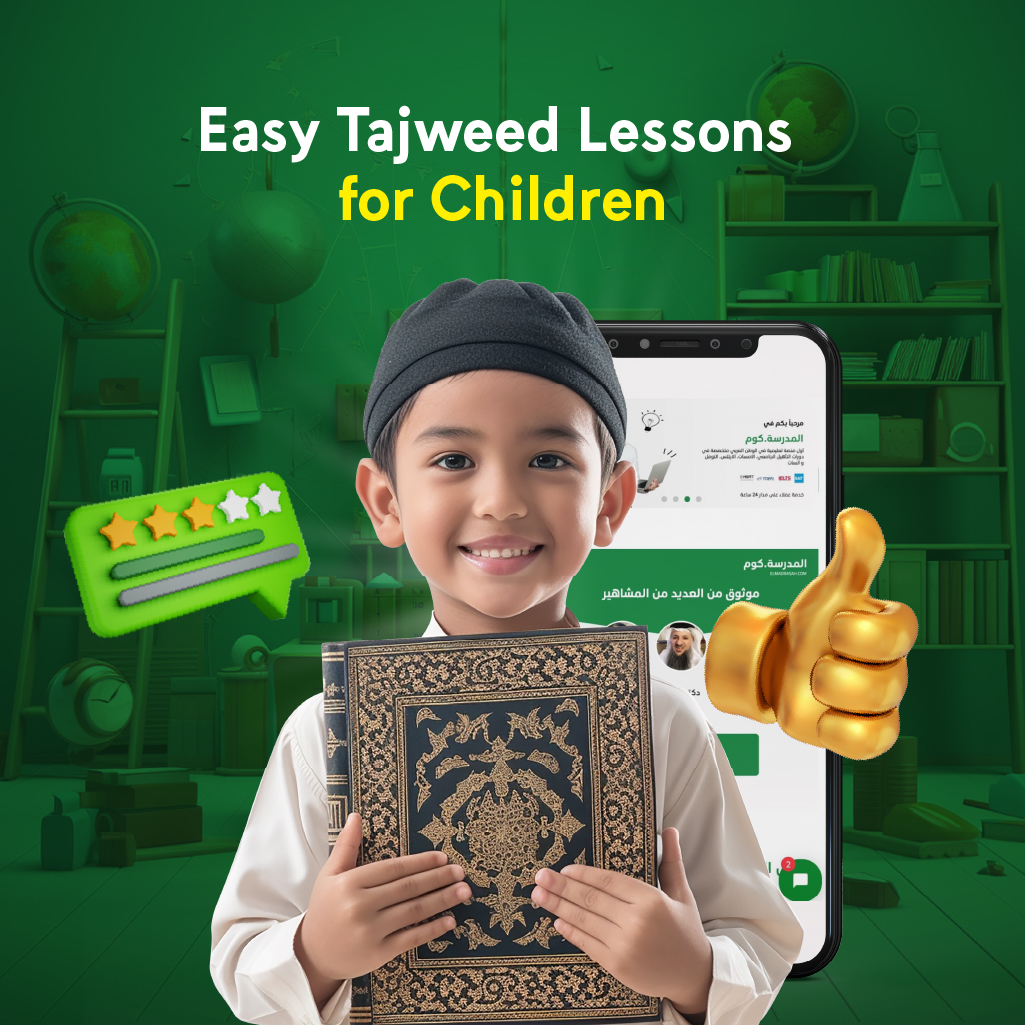
Teaching Tajweed to children is one of the most important tasks that parents and teachers should focus on from an early age. Tajweed is a fundamental component of learning and reciting the Quran correctly. Easy Tajweed lessons for children are not just theoretical lessons; they are an educational process aimed at instilling religious and moral values in children’s hearts through the proper recitation of the Quran as it was revealed.
Tajweed involves improving pronunciation and clarifying the correct articulation points of letters, as well as controlling the phonetic attributes of letters such as nasal sounds, elongation, and assimilation. The principles of Tajweed are not as complicated as some might think, especially if they are presented to children in a simplified and engaging manner. Starting to teach Tajweed at an early age helps strengthen the child’s Arabic language skills and makes them more capable of reading the Quran fluently and accurately.
The Importance of Teaching Tajweed to Children
Teaching Tajweed to children is considered a part of correct Islamic education, as it enhances children’s love for the Quran and helps them remain connected to it throughout their lives. EasyTajweed lessons for children help them understand the meanings of the Quran in a deeper way and contribute to improving their pronunciation and mastery of the Arabic language.
Teaching Tajweed for beginners typically begins with introducing children to the importance and virtues of Tajweed in improving recitation. It is explained that Tajweed is a means of enhancing recitation and not just difficult rules; rather, it is a style that makes the Quran recitation more beautiful and impactful. When a child understands this, they become more willing to learn and apply the principles of Tajweed.
Innovative Methods in Teaching Tajweed to Children
It is essential that easy Tajweed lessons for children are engaging and enjoyable to ensure their interaction and continued learning. Innovative methods in teaching Tajweed include using Quranic stories as an introduction to teaching the rules. For example, the story of Prophet Yusuf (Joseph) can be used to teach children how to pronounce letters correctly while reading verses.
Songs and hymns containing Quranic verses, while applying Tajweed rules in singing, can also be used. This method allows Tajweed principles to easily seep into children’s minds without much effort. Additionally, educational games such as letter cards and coloring games that focus on teaching articulation points and attributes of letters can be used.
Small competitions that encourage children to recite the Quran with correct Tajweed are also effective methods for teaching Tajweed to beginners. Such activities make children compete positively and motivate them to improve their recitation of the Quran.
The Role of the Family in Teaching Tajweed to Children
Teaching Tajweed is not limited to schools or mosques; it should also start at home. The role of the family in teaching Tajweed is as important as the role of teachers. Parents can set a good example for their children by regularly reciting the Quran correctly.
Easy Tajweed lessons for children can begin with daily sessions at home where family members gather to recite the Quran together. Parents can explain the principles of Tajweed to their children in a simple and accessible manner and encourage them to apply what they have learned during these sessions.
Additionally, parents can use modern technological tools to teach their children Tajweed. There are many apps and websites that offer Tajweed lessons for beginners interactively and attractively. Such tools make the learning process enjoyable and help children continue their Tajweed lessons even outside of school hours.
The Role of Teachers and Schools in Teaching Tajweed
Alongside the family’s role, teachers and schools play a crucial role in delivering easyTajweed lessons for children systematically and organized. Teachers are the cornerstone of the Tajweed education process; they must be well-versed in methods for teaching Tajweed to beginners and how to present its principles in a manner suited to children’s comprehension levels.
In schools, there should be a clear curriculum for teaching Tajweed that includes both theoretical and practical lessons. These lessons should include practical exercises on reciting the Quran with a focus on correcting common pronunciation errors. Teachers can use audio-visual aids to demonstrate how to pronounce letters and Quranic segments correctly.
Periodic workshops can also be organized to train children on applying Tajweed principles through group and individual recitation. These workshops provide children with opportunities to listen to their peers’ recitations and learn how to improve their own recitation through feedback and guidance from teachers.
Challenges in Teaching Tajweed to Children
Despite the importance of easy Tajweed lessons for children, there are some challenges that may hinder the learning process. One of the main challenges is the significant disparity in children’s pronunciation and language levels, where some children find it difficult to learn articulation points and letter attributes, making the learning process take longer.
Additionally, a shortage of qualified teachers in some schools can be a barrier to providing effective Tajweed education for beginners. Therefore, efforts should be made to train and qualify teachers to handle these difficulties and ensure the presentation of Tajweed principles in a manner that meets the diverse needs of children.
Moreover, excessive reliance on technological means may sometimes lead to neglecting personal interaction between the teacher and the student, which is an essential element in teaching Tajweed. Therefore, there should be a balance between using technology and direct interaction to ensure that children receive a comprehensive educational experience.
The Role of Elmadrasah.Com in Teaching Tajweed to Children
The website elmadrasah.Com is one of the leading platforms offering easyTajweed lessons for children in a modern and innovative way. This site aims to facilitate the process of learning Tajweed for children by providing comprehensive educational content suitable for various age levels.
Elmadrasah.Com offers a variety of educational resources that assist in teaching Tajweed for beginners in a simple and easy manner. Children can learn Tajweed principles through interactive video lessons that explain how to pronounce letters and apply Tajweed rules correctly.
Additionally, the site allows children to interact with Tajweed teachers and specialists through live online educational sessions. This provides children with immediate feedback on their performance and helps correct any mistakes they may make during recitation.
Elmadrasah.Com also provides a range of interactive tests that help children assess their level in easy Tajweed lessons for children. These tests offer immediate feedback that helps children identify areas needing improvement and work on developing their skills continuously.
Motivating Children to Learn Tajweed
Motivating children to learn Tajweed is an integral part of the education process. Teachers and parents should use encouraging methods to help children continue learning Tajweed principles. Among these methods are using stories and religious situations that highlight the importance of learning Tajweed and applying it in daily life.
Educational trips to mosques where children can observe live applications of Tajweed rules by listening to professional imams can also be organized. These experiences have a significant impact on children’s minds and motivate them to strive for improving their Quran recitation.
Furthermore, using a reward system to motivate children to learn Tajweed for beginners can be effective. Offering symbolic prizes or certificates of appreciation to children who show progress in learning Tajweed can be a strong incentive for them to continue.
The Impact of Learning Tajweed on a Child’s Personality
Learning Tajweed not only improves recitation but also has a significant impact on shaping a child’s personality. When a child learns easy Tajweed lessons for children correctly, they develop patience and precision in handling Quranic texts, which reflects on their thinking and approach to life’s matters.
Learning Tajweed principles also enhances a child’s focus and attention to detail, which are essential skills for excelling in various educational and life fields. Additionally, learning Tajweed boosts a child’s self-confidence, as they feel proud when reciting the Quran correctly in front of others.
The Importance of Repetition and Practice in Teaching Tajweed to Children
Repetition and practice are crucial elements in teaching easy Tajweed lessons for children. Through continuous repetition of Quran recitation and applying Tajweed principles, children can master Tajweed and solidify the rules in their memory. Repetition helps in cementing concepts and making them part of children’s daily routines, which makes it easier for them to apply them automatically in the future.
Allocating a specific time daily for reciting the Quran and reviewing Tajweed for beginners can have a significant impact on children’s progress. These regular sessions provide children with the opportunity to correct their mistakes and gradually improve their recitation. Parents and teachers can use various means such as audio recordings and monitoring children’s progress through listening to their recitations and providing necessary guidance.
The Role of the Community in Supporting Tajweed Education for Children
The community plays a vital role in supporting easy Tajweed lessons for children. The community can contribute to encouraging children to learn Tajweed by providing a supportive and motivating environment. For instance, mosques can organize special educational programs for children that include teaching Tajweed for beginners, with lessons presented in a manner appropriate for their ages and levels.
Community institutions can also organize Quranic competitions that motivate children to improve their Tajweed skills. These competitions foster positive competition among children and encourage them to put in more effort to achieve higher levels of proficiency in Tajweed principles. Additionally, the community can support initiatives aimed at training teachers and equipping them with the skills necessary to teach Tajweed effectively.
Future Challenges in Teaching Tajweed to Children
Despite significant advancements in methods for teaching easy Tajweed lessons for children, there are future challenges that may affect the educational process. Among these challenges is the rapid technological development that might cause distraction for children and reduce their focus on learning Tajweed. Therefore, parents and teachers should guide children toward using technology in a positive and beneficial way, such as using educational apps designed for Tajweed for beginners.
Also, some areas may face a shortage of qualified teachers to provide effective Tajweed lessons for children. This requires greater efforts from educational and community institutions to provide necessary training for teachers and improve the quality of education. Additionally, there may be cultural and social challenges related to varying levels of interest in teaching Tajweed among families and communities, which necessitates raising awareness about the importance of Tajweed principles and their impact on nurturing future generations.
In conclusion, easyTajweed lessons for children remain one of the most important pillars to focus on to ensure the development of a generation capable of reciting the Quran correctly and beautifully. We all—parents, teachers, and the community—must collaborate to provide the best means and tools to aid in teaching Tajweed to beginners and recognize that teaching Tajweed principles is not merely an educational task but a foundation for values and ethics that reflect on a child’s life as a whole.















